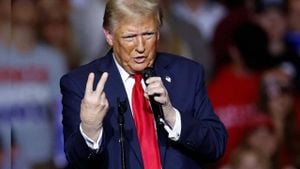With the 2024 U.S. presidential election heating up, the shifting dynamics of the Latino vote are taking center stage, particularly as both major parties scramble to understand and cater to this increasingly pivotal demographic. Recent elections have revealed noteworthy trends—especially among Latino men and Hispanic voters—that could spell trouble for Democrats and open doors for Republicans.
Polls indicate Donald Trump made significant strides, especially with Latino men, who have shown growing support for the former president's policies and campaign rhetoric. A Suffolk University/USA Today poll found Latino men under 50 favoring Trump decisively, showcasing challenges for Democrats like Vice President Kamala Harris, who struggles to connect with this group. Pollster David Paleologos commented, “Looking at the data, it was all about inflation/economy and immigration,” underscoring the priorities influencing this demographic.
Harris and the Democratic campaign are aware of the uphill battle. Despite her campaign's efforts, it appears they entered the election 7 percentage points short of where they needed to be among Latino voters. Gerald de la O, who supported Trump previously, noted he was impressed with Harris’ economic policies: “Her economic plan to give the middle class their money back sounded pretty good.” Interestingly, these sentiments reflect the ambivalent nature of loyalty among voters, demonstrating their willingness to gravitate toward initiatives they perceive as beneficial, regardless of party lines.
The Latino vote performed surprisingly differently across various states. While Kamala Harris garnered the majority of the Latino vote, it was with markedly decreased margins compared to previous elections. According to the Marquette Law School polling data, Democrats enjoyed a 61 percent advantage previously; this shrank to just 42 percent this year. The trends were particularly evident in Wisconsin where Trump's influence grew among Latino voters, showing how dynamics have shifted within key battleground states.
Hispanic voters are not monolithic, and their preferences are informed by various issues. Ricardo Torres from the Milwaukee Journal Sentinel highlighted the common ground among Latinos, noting their concerns align with economic stability, safe neighborhoods, and general quality of life—issues shared across demographic lines.
More insight stems from election analysts like Sean Trende who remarked on Trump’s unexpected gains, particularly emphasizing his ability to flip counties previously considered Democratic strongholds. This reality prompts political experts to ponder the sustainability of this movement among Latino voters heading toward 2024. Eva Zubik, with the Democratic Party, reflects on the challenges Democrats face, “We never saw this coming. We underestimated Latino support for Trump.”
Wisconsin stands as a microcosm for these larger trends. Harris managed to win the majority of votes among Latino populations, yet the frequentized shift toward Republicans is evident. Many observers noted differences in outreach strategies: Republicans held more public and accessible events, piquing interest—and garnering support—in Latino communities, contrasting with the Democrats' more private traditional methods. It raises questions not only about messaging but also about engagement methods.
The trends also bubbled to the surface within urban centers such as Chicago and New York, where Trump not only made gains but repositioned Republican presence within Democratic-dominated areas. Reports indicated Trump nearly doubled his support within Chicago compared to the previous election, tallying 22 percent among voters, showcasing his enhanced grasp on traditionally blue areas.
Michael Nutter, former mayor of Philadelphia, encapsulated the sentiment shifting among voters: “Folks are examining what affects them directly—financial health, education, jobs—those concerns clouds traditional allegiances.” This focus on economic outlooks reflects patterns observed across several major urban areas where disenchantment with Democratic policies led voters to explore options across the aisle.
To understand this complex shift, experts note it's imperative to examine underlying sentiments and concerns rather than merely voting behavior. Election communications strategist Maria Sanchez pointed out, “Republicans tapping mainstream issues resonates more deeply with voters who may have felt ignored.”
Yet it is also worth noting the lessons from the Democratic perspective as they reconsider strategies to adequately retain their traditional base. The failure to secure clear messaging and outreach could lead to unforeseen consequences, leading to potential policy shifts among officials who may prioritize Latino voters moving forward. Political scientist Luis Jimenez remarked, “Both parties must recognize the growing power of Latino votes—and more critically, they need to listen and adapt.”
Looking toward the 2024 election, political analysts agree Latino voters may dictate many outcomes, especially within battleground states where marginal leads carry significant weight. Traditional voting patterns are disrupting, and political organizations are redefining the frameworks within which campaigns operate, recognizing the nuanced needs of the Latino electorate.
With the election calendar continuing to advance, all eyes have turned toward these rapidly changing dynamics. Both parties are now challenged to connect with this demographic—facing the parallel issues of misunderstanding and outreach hurdles, setting the stage for pivotal shifts within the American political narrative as 2024 approaches.
Speculations point to the Latino vote possibly becoming the deciding factor across key states. The strategic decisions made now will likely resonate far beyond November next year, shaping the political framework for future contests. While overall margins are narrowing, the reality proves clear: Latino voters are here to stay, and their impact remains to be fully realized through consistent engagement and appropriate messaging from both sides of the aisle as they evaluate the political ecosystem.



